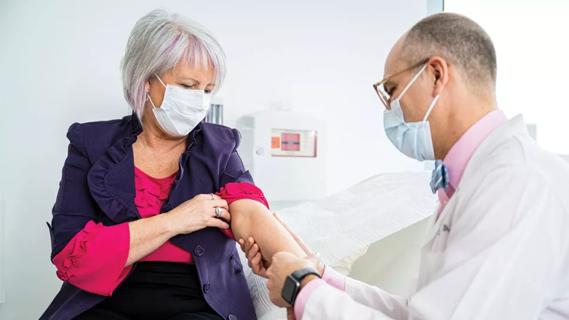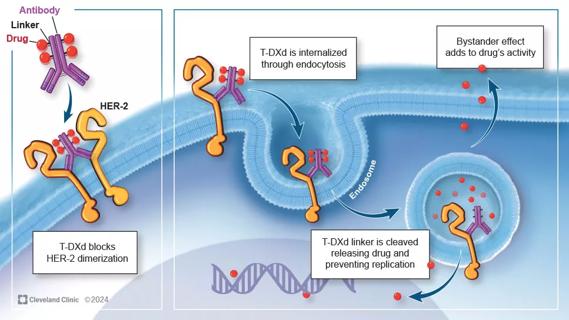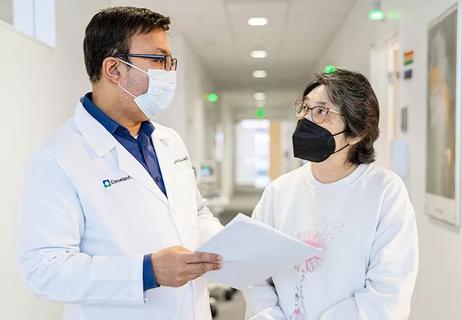The first prospective randomized scalp cooling trial in the world has revealed that the Orbis Paxman Hair Loss Prevention System (OPHLPS) — which works by reducing the temperature of the scalp a few degrees immediately before, during and after chemotherapy — is highly effective for preserving hair in women receiving neoadjuvant or adjuvant chemotherapy for early-stage breast cancer. The OPHLPS was so effective at reducing the incidence of chemotherapy-induced alopecia that the trial was halted early upon interim analysis. The results, including efficacy and safety data, were presented at the 2016 San Antonio Breast Cancer Symposium on Dec. 9.
Cleveland Clinic is a non-profit academic medical center. Advertising on our site helps support our mission. We do not endorse non-Cleveland Clinic products or services. Policy
All the patients in the trial had stage I or II breast cancer and underwent anthracycline or taxane-based chemotherapy for at least four cycles. “The interim results revealed that 48 of 95 patients in the intervention group, or 50.5 percent were able to preserve their hair, while none of the 47 patients in the control group kept their hair,” said one of the investigators, Jame Abraham, MD, Director of Cleveland Clinic Cancer Center’s Breast Oncology Program, and Co-Director of the Comprehensive Breast Cancer Program. In the trial, hair preservation was defined as CTCAE 4 (Common Terminology Criteria for Adverse Events, version 4) alopecia that did not reach grade 2.
“Hair loss is a very important concern for women undergoing chemotherapy, and scalp cooling offers a very viable option for them to help preserve their hair,” Dr. Abraham says. “Women with breast cancer consider alopecia as one of the most severe and distressing side effects of chemotherapy. It can have a huge psychological impact on patients.” Patients were randomized in a 2:1 ratio to scalp cooling or no scalp cooling. Women included for study had no history of migraine headaches. During the trial, women who were treated with scalp cooling wore a cap or helmet with circulating cooling fluid for half an hour before chemotherapy, during chemotherapy administration, and for 90 minutes after the completion of chemotherapy. Patients in the control group did not wear any cap before, during or after their treatment. The interim results of the trial revealed that there were no serious adverse events, and all adverse events were grade 1 and 2, and included side effects such as chills, headache and nausea.
Secondary endpoints in the trial were wig or scarf use and quality of life as assessed by the EORTC, QLG-30, HADS and BIS questionnaires. Among the women in the intervention group, 54 percent wore wigs or head wraps after receiving the scalp cooling treatment, while 100 percent in the control group used wigs or head wraps. Quality of life data also showed greater benefits for the intervention group than for women in the control group.
The hair loss prevention system in this study uses cooling fluid to keep the helmet and scalp cold, causing cutaneous vasoconstriction, also potentially resulting in reduced biochemical activity. This may help reduce cellular uptake of the agents and/or decrease susceptibility of hair follicles to chemotherapy-induced damage. Hair follicles in the growth phase are sensitive to chemotherapy, resulting in alopecia approximately two weeks after treatment begins. Effectiveness of scalp cooling for hair preservation varies by chemotherapy type and dose, and some evidence also suggests by the degree and duration of cooling.
Researchers with the scalp cooling trial planned to enroll 235 patients in the intervention and control groups of the trial, but an interim analysis was planned after 95 patients in the scalp cooling group completed treatment, and 45 patients in the control group were evaluated. Study participants will be followed for five years to assess time to first recurrence, overall survival, site of first recurrence and incidence of isolated scalp metastases. One of the concern with scalp cooling is the potential for increased rate of scalp metastases, but the risk for this complication has been low in previous studies — less than 2.5 percent. Previous studies have not found a difference in survival between women with breast cancer who received scalp cooling and those who did not.
The results of the trial will be submitted to the FDA by the Paxman company, makers of the OPHLS, as a treatment for chemotherapy-induced hair loss in breast cancer patients. In a statement announcing the results of the study and the FDA application, spokespersons for the Paxman company said: “The San Antonio Breast Cancer Symposium is the ideal venue for the debut of this research, and we are thrilled to see such promising results. We look forward to hearing from the FDA regarding filing, and will be working hard to achieve the next step on bringing this technology to clinics.”
Update April 20, 2017: The FDA has now approved this device.

First-of-its-kind research investigates the viability of standard screening to reduce the burden of late-stage cancer diagnoses

Study demonstrates ability to reduce patients’ reliance on phlebotomies to stabilize hematocrit levels

Findings highlight an association between obesity and an increased incidence of moderate-severe disease

Cleveland Clinic Cancer Institute takes multi-faceted approach to increasing clinical trial access

Key learnings from DESTINY trials

Gene editing technology offers promise for treating multiple myeloma and other hematologic malignancies, as well as solid tumors

Study of 401,576 patients reveals differences in cancer burdens as well as overall survival

Enfortumab plus pembrolizumab reduced risk of death by 53% compared with platinum-based chemotherapy